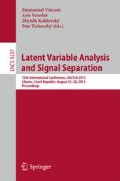Abstract
The task of blind source separation (BSS) is to recover original signal sources which are observed only via their superposition with unknown weights. Since we are interested in estimation of the number of relevant sources in noisy observation, we use the Bayesian formulation which automatically removes spurious sources. A tool for this behavior is joint estimation of the unknown prior covariance matrix of the sources in tandem with the sources. In this work, we study the effect of various choices of the covariance matrix structure. Specifically, we compare models using the automatic relevance determination (ARD) principle on the first and the second diagonal, as well as full covariance matrix with Wishart prior. We obtain five versions of the variational BSS algorithm. These are tested on synthetic data and on a selected dataset from dynamic renal scintigraphy. MATLAB implementation of the methods is available for download.
Access this chapter
Tax calculation will be finalised at checkout
Purchases are for personal use only
Notes
References
Araújo, M.C.U., Saldanha, T.C.B., Galvão, R.K.H., Yoneyama, T., Chame, H.C., Visani, V.: The successive projections algorithm for variable selection in spectroscopic multicomponent analysis. Chemometr. Intell. Lab. Syst. 57(2), 65–73 (2001)
Bishop, C.M.: Variational principal components. In: IET Conference Proceedings, pp. 509–514(5), January 1999
Gaspari, G., Cohn, S.E.: Construction of correlation functions in two and three dimensions. Q. J. Roy. Meteorol. Soc. 125(554), 723–757 (1999)
Gillis, N.: Successive nonnegative projection algorithm for robust nonnegative blind source separation. SIAM J. Imaging Sci. 7(2), 1420–1450 (2014)
Hamill, T.M., Whitaker, J.S., Snyder, C.: Distance-dependent filtering of background error covariance estimates in an ensemble kalman filter. Mon. Weather Rev. 129(11), 2776–2790 (2001)
Hyvärinen, A., Karhunen, J., Oja, E.: Independent Component Analysis, vol. 46. Wiley, New York (2004)
Lee, D.D., Seung, H.S.: Algorithms for non-negative matrix factorization. In: Proceedings of Advances in neural information processing systems, pp. 556–562 (2001)
Margadán-Méndez, M., Juslin, A., Nesterov, S.V., Kalliokoski, K., Knuuti, J., Ruotsalainen, U.: ICA based automatic segmentation of dynamic cardiac PET images. IEEE Trans. Inf. Technol. Biomed. 14(3), 795–802 (2010)
Miskin, J.W.: Ensemble learning for independent component analysis. Ph.D. thesis, University of Cambridge (2000)
Moussaoui, S., Hauksdottir, H., Schmidt, F., Jutten, C., Chanussot, J., Brie, D., Douté, S., Benediktsson, J.A.: On the decomposition of mars hyperspectral data by ica and bayesian positive source separation. Neurocomputing 71(10), 2194–2208 (2008)
Šmídl, V., Quinn, A.: The Variational Bayes Method in Signal Processing. Springer, Heidelberg (2006)
Šmídl, V., Quinn, A.: On bayesian principal component analysis. Comput. Stat. Data Anal. 51(9), 4101–4123 (2007)
Tichý, O., Šmídl, V.: Non-parametric bayesian models of response function in dynamic image sequences. Pre-print submitted to Computer Vision and Image Understanding (arXiv:1503.05684 [stat.ML]) (2015)
Tipping, M.E.: Sparse bayesian learning and the relevance vector machine. J. Mach. Learn. Res. 1, 211–244 (2001)
Tipping, M.E., Bishop, C.M.: Probabilistic principal component analysis. J. Roy. Stat. Soc. B (Stat. Methodol.) 61(3), 611–622 (1999)
Acknowledgement
This work was supported by the Czech Science Foundation, grant No. 13-29225S, and by the Grant Agency of the Czech Technical University in Prague, grant No. SGS14/205/OHK4/3T/14.
Author information
Authors and Affiliations
Corresponding author
Editor information
Editors and Affiliations
A Shaping Parameters of Posterior Distributions
A Shaping Parameters of Posterior Distributions
Posterior distributions are \(\tilde{f}(A|D)=t\mathcal {N}_{A}(\mu _{A},I_{p}\otimes {\varSigma }_{A}),\) \(\tilde{f}(\xi _{k}|D)=\mathcal {G}_{\xi _{k}}\left( \phi _{k},\psi _{k}\right) ,\) \(\tilde{f}(\mathbf {x}|D)=t\mathcal {N}_{\mathbf {x}}\left( \mu _{\mathbf {x}},{\varSigma }_{\mathbf {x}}\right) ,\) \(\tilde{f}({\varUpsilon }|D)=\mathcal {W}_{{\varUpsilon },nr}\left( {\varSigma }_{{\varUpsilon }},\beta \right) ,\) \(\tilde{f}(\omega |D)=\mathcal {G}_{\omega }\left( \vartheta ,\rho \right) ,\) with shaping parameters \({\varSigma }_{A}^{-1}=\left( \omega \widehat{X^{T}X}+\widehat{\Xi }\right) ,\) \(\mu _{A}=\left( \omega D\widehat{X}\right) {\varSigma }_{A},\) \(\phi =\phi _{0}+\frac{p}{2}\mathbf {1}_{r,1},\) \(\psi =\psi _{0}+\frac{1}{2}\mathrm {diag}\left( {\widehat{A^{T}A}}\right) ,\) \({\varSigma }_{\mathbf {x}}^{-1}=\left( ({\widehat{\omega }}{\widehat{A^{T}A}})\otimes I_{n}+{\widehat{{\varUpsilon }}}\circ L\right) \) \(\mu _{\mathbf {x}}={\varSigma }_{\mathbf {x}}\left( {\widehat{\omega }}\mathrm {vec}\left( D^{T}{\widehat{A}}\right) \right) \) \({\varSigma }_{{\varUpsilon }}^{-1}=\left( {\widehat{\mathbf {x}\mathbf {x}^{T}}}+\alpha _{0}^{-1}I_{nr}\right) \) \(\beta =\beta _{0}+1\) \(\vartheta =\vartheta _{0}+\frac{pn}{2},\) \(\rho =\rho _{0}+\frac{1}{2}\mathrm {tr}\left( (D-{\widehat{A}}{\widehat{X^{T}}})(D-{\widehat{A}}{\widehat{X^{T}}})^{T}\right) .\)
Rights and permissions
Copyright information
© 2015 Springer International Publishing Switzerland
About this paper
Cite this paper
Tichý, O., Šmídl, V. (2015). Bayesian Blind Source Separation with Unknown Prior Covariance. In: Vincent, E., Yeredor, A., Koldovský, Z., Tichavský, P. (eds) Latent Variable Analysis and Signal Separation. LVA/ICA 2015. Lecture Notes in Computer Science(), vol 9237. Springer, Cham. https://doi.org/10.1007/978-3-319-22482-4_41
Download citation
DOI: https://doi.org/10.1007/978-3-319-22482-4_41
Published:
Publisher Name: Springer, Cham
Print ISBN: 978-3-319-22481-7
Online ISBN: 978-3-319-22482-4
eBook Packages: Computer ScienceComputer Science (R0)

